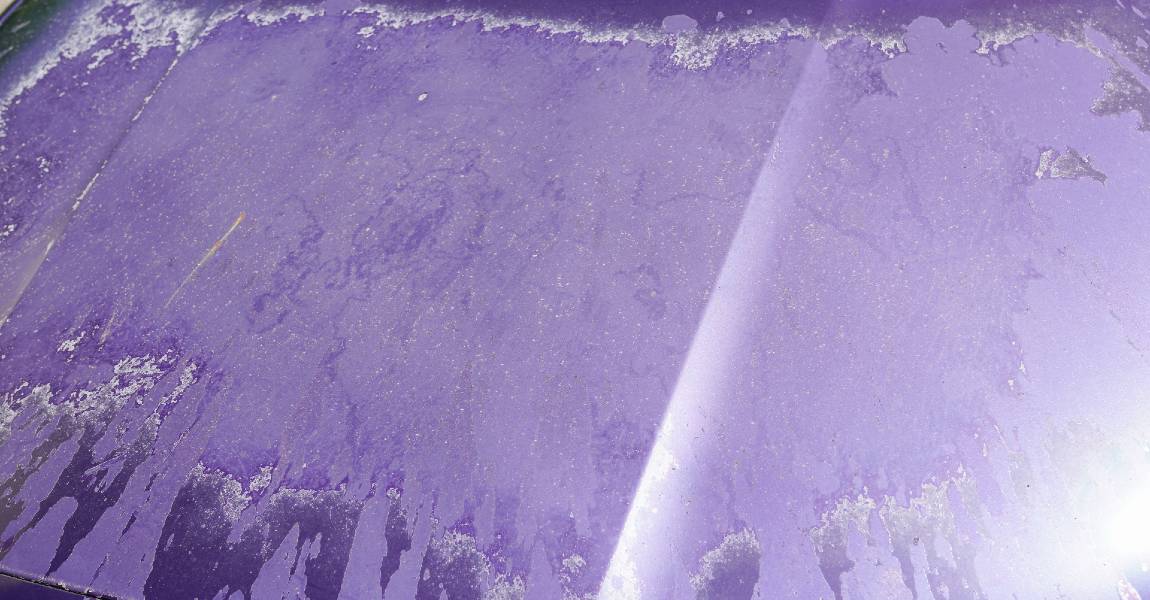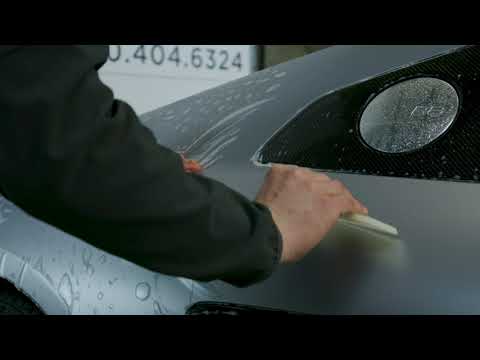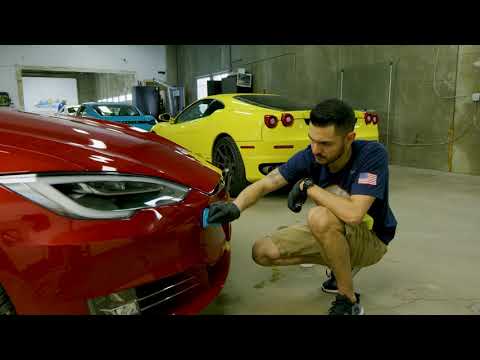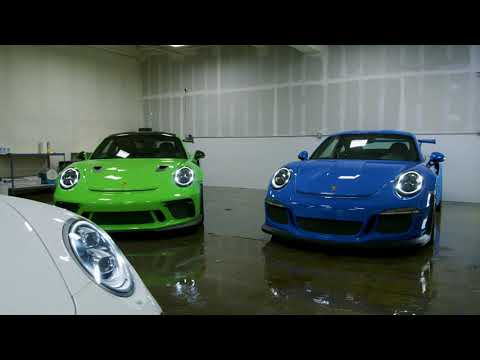Ever gone bare-chested to the beach on a hot summer afternoon? You most likely have worn sunscreen, or else the sunburn on your skin would have been glaring the next morning. Although all life on earth depends on that dazzling ball of gas high up in the sky, the sun’s UV rays can cause tremendous havoc to the skin—and to your car’s paint. So the million-dollar question is: how can you prevent the sun from damaging your car’s paint? Continue reading our Guide: How to Prevent Sun Damage to Your Car’s Paint,
You can prevent sun damage to a car’s paint by reducing exposure of the car’s clear coat to UV rays, and there are coating materials to do that, including ceramic coating. It’s a lot like wearing sunscreen.
In this article, we explore how to prevent sun damage to your car’s paint with tips and materials to achieve maximum protection.
First, the basics: how does the sun cause damage to your car?

- How Sunlight Damages Car Paint
- Do Some Paint Colors Fade Faster than Others Under UV Exposure?
- Factors that Contribute to Car Paint Fading
- Tips to Protect Car Paint From UV Damage
- Use Ceramic Coating to Prevent Sun Damage
- Benefits of Ceramic Coatings
- Is Ceramic Coating a Permanent Solution to Sun Damage?
- Conclusion
How Sunlight Damages Car Paint
Sunlight causes damage to the paint of your car through the emission of ultraviolet rays (UV rays). Although UV rays are invisible, they are extremely powerful. For humans, exposure to UV light can result in premature aging and skin cancer. As for a car, UV rays cause the paint to fade and clear coats to become yellow, making it look less reflective and appealing to the eyes.
Your car’s paint doesn’t change color; you just have a car that has been damaged by UV light over months of exposure.
But how does this chemical reaction work? This is it:
Ultraviolet rays are a form of electromagnetic energy. When this energy (UV light) hits the surface of your car, it induces the surface to react, producing some counter energy, which is given off as heat. Unfortunately, the energy your car is forced to give off results in the paint’s molecular bonds breaking up. This is the cause of cars paint fading over time.
The results aren’t visible overnight, as it is with your skin after prolonged exposure to harmful rays of the sun. But with time, you’re sure to observe your vehicle’s paint getting duller. This is because, over time, the molecules in car paint, clear coat, trim, and other parts of the car will break down and deteriorate. Eventually, the damage becomes so extensive that holes emerge in the layers of the clear coat, giving way to corrosion and oxidation, a precursor of rust.
Again, if you can reduce exposure of your car to harmful rays, damage to the paint molecules will be greatly minimized. Just the way sunblock acts as a protective layer between your skin and the sun, there are protective coatings for automotive paints, too.
But before looking into that, are some car paints more susceptible to sun damage than others?
Do Some Paint Colors Fade Faster than Others Under UV Exposure?
Light contains all the colors of the visible spectrum. And for you to see, light must be present. You do not see all the colors because only the color of the image you’re staring at is refracted into your eyes. All other colors are absorbed by the color of the object.
For example, when sunlight hits a blue car, light containing the car’s image is refracted into your eyes, and your brain tells you, “that’s a blue car over there.” So, in essence, when you’re looking at a blue vehicle, you’re actually looking at all the colors but only seeing blue because the car’s paint absorbs everything else.
Now, every color has a unique wavelength and energy level. A higher wavelength means lower energy. For example, red has the highest wavelength and, therefore, the lowest energy. That means a red car absorbs all other colors of higher energy, causing it to break down and fade faster.
Red, orange, and yellow will fade faster than green and blue due to their position in the visible light spectrum. Therefore, a blue-painted car will not fade as quickly as a red one.
On the other hand, white and black cars tend to stay sharper for longer because they are practically not colors. Silver and gray also tend to be more fade-resistant. Nevertheless, every car paint will experience damage due to extensive UV exposure; it’s just a matter of how long it takes. Hence, it’s in your best interest to take proactive steps to protect your car paint from sun damage.
So, now, how do you go about that?

Factors that Contribute to Car Paint Fading
Before discussing tips on protecting car paint from damage, it’s worth noting that UV rays aren’t the only culprit here. Other factors can contribute to the fading of your car’s paint, including:
Bird Droppings
Bird droppings contain harsh chemicals such as uric acid, which can accelerate the degradation of automotive paint, particularly the clear coat. The breakdown can begin in a matter of hours, so cleaning as quickly as possible is paramount.
Bugs Getting Squashed in High Speed
Your car tends to hit and squash bugs when at high speed. Like bird droppings, bug guts contain acids that are corrosive to automotive paints. Combined with UV exposure, these materials can cause significant damage to the paint within a short time.
Road Grime, Salt, and Debris
Salt (sodium chloride) can easily penetrate car wax and clear coating, opening a passage for UV rays to do heavy damage. Road grime which comprises tar, oil, gravel, and toxins, is also a nightmare for your car’s surface.
All of the above factors emphasize why washing your car is one of the best and easiest ways to protect the paint from sun damage.
Tips to Protect Car Paint From UV Damage
Washing is an excellent and easy way to protect car paint from fading due to UV rays. However, you must wash correctly through the two-bucket method.
The Two-Bucket Car Washing Technique
The two-bucket method involves washing the car with two buckets: one filled with soap water, the other with plain water. This allows you to immediately rinse away the soap and dirt from your washing mitt before dipping it into the soap water.
With a one-bucket wash system, your washing mitt accumulates dirt and grime as you wipe your car. When you need more suds, you dip the mitt into the bucket, transferring all the dirt and grime into the water. The water gets so dirty that whenever you bring a soapy mitt to your car’s surface, you’re bringing dirt and debris that may scratch and soil your car all the more. You end up doing more harm than good.
With the two-bucket method, you bring a relatively clean mitt back to your car’s surface every time you reach for more suds.
Pre-washing your car
Don’t just take water and start wiping with a washing mitt. Instead, pre-wash your car by spraying the entire body with a hose, so the pressure peels away the grime that has lodged on it. This is a greatly overlooked car washing technique. It can prevent swirl marks and ease up the actual washing process.
Drying after washing the car
Don’t use anything dirty to dry your car If you don’t want to leave swirl marks after washing. Instead, use a clean microfiber towel for hand drying your car. Preferably, have multiple towels so you can switch when one gets dirty.
Dry your car by wiping it in a side-to-side pattern, never in circles.

Use Ceramic Coating to Prevent Sun Damage
Many people use car carnauba wax and sealants to block UV rays; they’re good, just not the best. The best car cover to prevent sun damage to the paint is ceramic coating.
Ceramic coating provides a durable layer of protection that prevents UV rays from penetrating your car’s clear coat. It accomplishes this by using nanotechnology to fill microscopic pore spaces present in the clear coat and car paint, producing a layer impenetrable to the harmful effects of UV light.
Since the ceramic coating is transparent, you’ll still see your shiny car paint in all its glory. The coating also has glossy, lustrous qualities, adding to your car’s visual appeal.
The lustrous effects of ceramic coatings allow them to deflect UV rays, thereby reducing the possibility of car paint’s molecular breakdown.
Benefits of Ceramic Coatings
Ceramic coatings have become a force in the detailing industry for the benefits they provide. Some of these benefits include:
- It prevents sun damage to your car
- It has a slippery surface that prevents bird droppings, dust, and grime to stick
- The hard and impervious surface makes it resistant to corrosion and oxidation
- Since dirt doesn’t always stick, your car will require less washing and maintenance
- The hardness of ceramic coatings also means your car is less prone to scratch
Interestingly, ceramic coating application isn’t limited to automotive paints. They can be applied to any solid surface, such as wheels, plastic trims, paint protection film (PPF), windshields, vinyl wrap, and leather seats.
In short, ceramic coatings provide comprehensive protection for your car.

Is Ceramic Coating a Permanent Solution to Sun Damage?
Unlike car wax and paint sealants, ceramic coatings don’t wear out easily. For example, Ceramic Pro offers a permanent, invisible glass shield when fully cured. No worries about going for frequent auto paint jobs within the next 2-5 years.
Conclusion
Sun damage is one of the greatest causes of concern to car owners all over the globe. But when you’re living closer to the equator, or in Denver the damaging effects of sunlight on car paint increase exponentially.
Installing ceramic coating is a worthy investment if you want peace of mind about your new car losing its shine quickly. It can potentially save money and time on washing and regular paint jobs.
Get the most out of your car without worrying about paint fading. Learn more about protecting your vehicle paint with Denver automotive ceramic pro coating. Contact us today.




